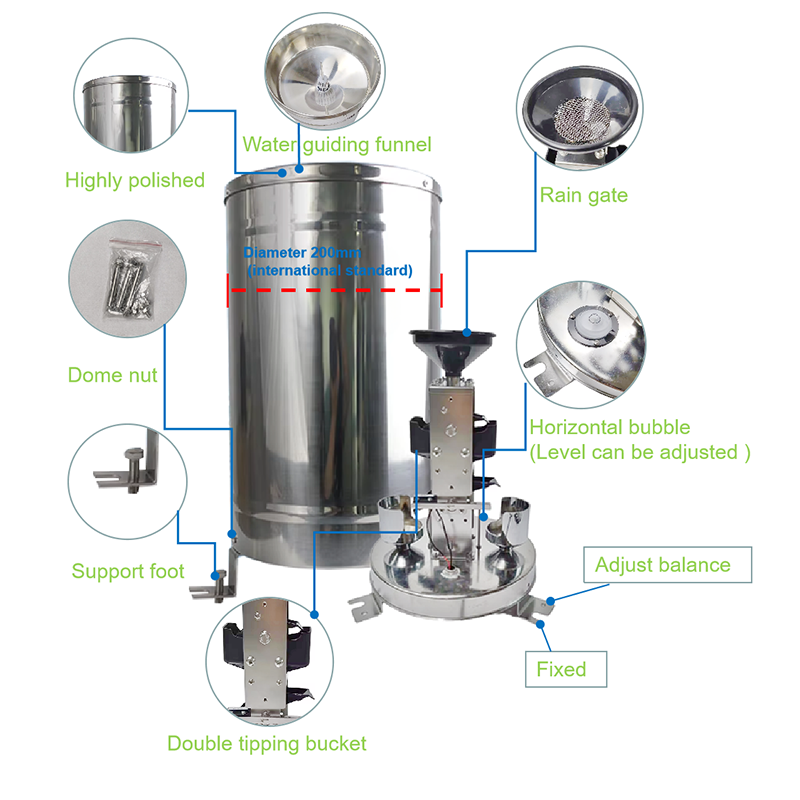1. Technological Advancements in Rain Gauge Sensors
Recent advancements in rain gauge technology have improved accuracy and reliability in measuring rainfall, which is crucial for effective weather forecasting and water resource management. Companies like Honde Technology Co., Ltd. are at the forefront of developing new digital rain gauges equipped with wireless communication capabilities, providing real-time data to meteorological agencies and research institutions. These sensors can automatically calibrate and adjust to local conditions, enhancing data quality and precision.
2. Integration with IoT and Smart City Initiatives
The integration of rain gauge sensors with Internet of Things (IoT) technology is driving significant advancements in urban planning and flood management. Cities worldwide are adopting smart city frameworks, where rain gauges play a vital role in monitoring precipitation levels. For instance, cities like Manila in the Philippines are utilizing IoT-based rain gauges that transmit data in real time, allowing for better flood prevention measures and responsive infrastructure management. Honde Technology Co., Ltd. is actively involved in providing IoT-enabled solutions that enhance the capabilities of smart city initiatives.
3. Collaborations with Research Institutions
Partnerships between government meteorological agencies and research institutions are facilitating the development and deployment of more efficient rain gauge monitoring systems. For example, the Philippine Atmospheric, Geophysical and Astronomical Services Administration (PAGASA) has collaborated with local universities to enhance rain gauge networks in flood-prone areas. This initiative aims to improve rainfall data accuracy, supporting more effective flood forecasting and disaster management strategies. Honde Technology Co., Ltd. has also engaged in collaborations to provide advanced rain gauge technology and expertise in various regions.
4. Deployment in Disaster Response Efforts
The role of rain gauge monitoring in disaster response continues to grow, especially in countries prone to severe weather events. Agencies are deploying advanced rain gauges in vulnerable regions to enhance early warning systems. By monitoring rainfall intensity and accumulation, these sensors provide critical information needed for timely evacuation orders and resource allocation during storms and flooding incidents. Companies like Honde Technology Co., Ltd. are contributing their technological innovations to ensure that these systems are effective in disaster-prone areas.
5. Funding and Support from International Organizations
International organizations and NGOs are increasingly supporting the installation of rain gauge systems in developing countries. These initiatives often focus on enhancing community resilience to climate change by providing accurate rainfall data. Programs funded by entities like the World Bank are equipping rural areas with state-of-the-art rain gauge technology, along with training for local personnel on data interpretation and usage. As part of these efforts, Honde Technology Co., Ltd. is involved in providing accessible rain gauge solutions to bolster these initiatives.
6. Environmental Monitoring and Climate Research
Rain gauge sensors are becoming essential tools for climate research and environmental monitoring. Researchers are utilizing data collected from these sensors to study rainfall patterns, analyze climate change impacts, and assess water resource availability. This data is critical for developing more accurate climate models and informing policy decisions related to water management and climate adaptation strategies. Honde Technology Co., Ltd. contributes to this field by offering advanced sensors that enhance data collection and analysis efforts.
7. Emerging Trends in Data Analytics
The proliferation of data analytics tools has enabled more sophisticated analysis of rainfall data collected by rain gauges. Organizations are employing machine learning algorithms to identify patterns and predict future rainfall events based on historical data. This trend enhances the ability of meteorologists and researchers to provide accurate forecasts, contributing to better planning and response efforts. Honde Technology Co., Ltd. is also exploring ways to integrate data analytics with their rain gauge solutions to deliver more actionable insights.
8. Future Directions
Looking ahead, the future of rain gauge monitoring sensors is promising. With ongoing innovations, including the development of more portable and cost-effective sensors, there is potential for wider adoption in remote and underserved communities. Additionally, collaborations between the public sector, private companies like Honde Technology Co., Ltd., and academic institutions will likely lead to enhanced systems for data integration and application.
Conclusion
Rain gauge monitoring sensors are playing an increasingly critical role in managing water resources, mitigating the impacts of climate change, and enhancing disaster preparedness. As technology continues to evolve and more resources are directed toward improving these systems, the ability to monitor and respond to rainfall accurately will be a cornerstone of effective environmental management and climate resilience strategies.
For the latest updates on rain gauge monitoring technologies and their applications, follow developments from meteorological agencies, environmental organizations, and technology providers like Honde Technology Co., Ltd.
Post time: Oct-25-2024


